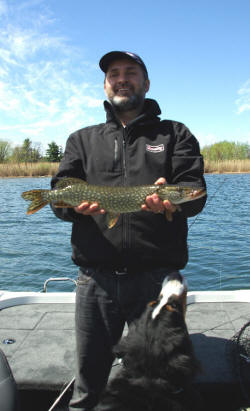
Exploring a Fishís Sense of Taste
By Lawrence Gunther Euteneier /
Feel the Bite!
www.blindfishingboat.com
A friend who recently regained
his sight after a lifetime of
being blind said sight can be
quite perplexing. Seeing an
object for the first time offers
few clues about its nature,
making touching, smelling and
tasting crucial to gaining
understanding. All intelligent
life forms utilize all their
senses to explore their world.
The difference between us and
fish is that we have hands for
grasping and touching, whereas
fish have only their mouths.
Fish have no concept of
ďartificialĒ, and survive by
sorting their environment
according to what tastes and
feels good, and what doesnít.
Other than those few weeks each
year when spawning becomes
central in their lives, the rest
of the time is spent refining
their foraging skills.
 Beach
goers who are victims of shark
attacks are often unaware that
an ďattackĒ took place until
they look down and notice that
their leg is bleeding. Most
report feeling only a slight
bump. Itís not that the shark
wasnít able to actually bite off
a peace of leg, but simply
wanted to have a taste. The
reason these beach goers still
have their legs is because itís
a taste that sharks arenít
conditioned to associate with
food. Thatís not to say that
there isnít a handful of shark
species out of the over 500
varieties that wouldnít hesitate
triggering a feeding frenzy
involving humans, such as Bull
Sharks -- responsible for eating
more downed pilots during the
second world war than all other
species combined.
Beach
goers who are victims of shark
attacks are often unaware that
an ďattackĒ took place until
they look down and notice that
their leg is bleeding. Most
report feeling only a slight
bump. Itís not that the shark
wasnít able to actually bite off
a peace of leg, but simply
wanted to have a taste. The
reason these beach goers still
have their legs is because itís
a taste that sharks arenít
conditioned to associate with
food. Thatís not to say that
there isnít a handful of shark
species out of the over 500
varieties that wouldnít hesitate
triggering a feeding frenzy
involving humans, such as Bull
Sharks -- responsible for eating
more downed pilots during the
second world war than all other
species combined.
While the degree to which
different species of fish rely
on their sense of taste is
determined primarily by their
preferred style of foraging, the
importance an individual fish
places on a specific sense has
also to do with their attitude
at the time. Aggressive or
feeding fish are often competing
with other fish and have less
time to exercise caution, and
while curious fish might explore
their world utilizing all their
senses, neutral or negative
feeling fish will rely more on
their longer range senses such
as hearing, feeling and sight,
before moving in closer to
smell, touch and taste.
Eyes situated on the sides of
heads of Catfish and Carp offer
little foraging assistance. The
more such species dwell in
low-light environments the more
they depend on taste, which in
turn has led to their evolving
increasingly more taste sensors.
Taste buds are not only located
inside a fishís mouth, but often
on the sides of their faces,
gills and fins, and in the case
of Carp and Catfish, along their
barbels (whiskers) and the sides
of their bodies. Surprisingly
though, fish have no taste buds
on their tongues.
Fish survive through to
adulthood by depending on their
inherited instincts, and thrive
by conditioning their behaviours
through repeated negative and
positive experiences. If a fish
learns to associate a certain
shape and colour of artificial
bait with having their butts
kicked, then adding a bit of
scent isnít going to change
their mind. However, trying a
different shape, colour or
presentation style just might.
While Bass too use their sense
of taste to sort out their world
into edible and non-edible, they
depend more on their hearing and
sight. Using reaction baits to
catch Bass doesnít involve taste
at all. From the time a Bass
strikes until itís hooked is
often miniscule, which means
Bass have little chance to
reject reaction baits for
reasons of taste, smell and
touch.
Taste becomes more relevant when
fishing for Bass using slower
moving baits such as plastics.
Senkos were never designed to
mimic exactly what Bass normally
eat. Bass find their shape
intriguing though, which leads
to their taking the next step
and striking. Once in the Bassís
mouth, Senkos feel life-like,
and as long as they donít taste
or smell inedible, it doesnít
take long before their down the
hatch.
Adding scent to plastics can
assist in triggering neutral or
negative feeling fish to strike,
and can serve to mask unnatural
scents such as tobacco, sun
block, insect repellent or hand
sanitizer. If youíre careful how
you store and handle your soft
plastics however, the use of
fish attractants on plastics for
aggressive predators such as
Bass, Musky or Pike is more of
an option then a necessity.
No doubt, the priority placed on
specific senses by a fish will
depend on a variety of factors
such as foraging style, water
clarity and temperature, light
levels, competitive pressure,
the presents of known or unknown
threats, spawning instincts,
reaction time, etc. Thus, the
odds of your bait passing the
different sensory tests applied
by aggressive, feeding, curious
or neutral fish will improve by
thinking of your bait as a
complete package.
.
Ontario Ice
Fishing